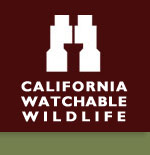

| Visitation: 1million+ | ||
| Area: 220 Acres | ||
| Lat: | ||
| Lon: | ||
| Nearby Services | ||
| Site Facilities | ||
| Join Our Mailing List |
|
For Email Marketing you can trust
|
Top Banner Photo Credits
Pam Starr
Alyn Robert Brereton
Julie MacKinnon
Linda Pittman
Parham Pourahmad
Larry Whiting
Randall Finley
Pam Starr
Alyn Robert Brereton
Julie MacKinnon
Linda Pittman
Parham Pourahmad
Larry Whiting
Randall Finley
© 2008-2024 California Watchable Wildlife and Blue Cat Studio, Inc.
| Lake Merritt - Site # 112 | |||
| Known as the 'Jewel of Oakland' this lake set amid businesses and skyscrapers is North America's first wildlife refuge. Paved walkways encircling the lake provide excellent viewing. America's Oldest Wildlife Refuge, Lake Merritt comes from a wide, tidal estuary (salt water marsh) that was known as the Laguna Peralta. The Pacific Flyway has remained a sanctuary and stop-over for thousands of migratory birds. Dr. Merritt declared the lake a National Wildlife Refuge in 1869. On March 18th, 1870, Lake Merritt became the first protected wildlife refuge in America. | |||
| Background: | Five densely vegetated islands shelter 50 nesting waterbird species. Resident Canada geese raise about 100 goslings annually. Island trees are a rookery for snowy egrets, great egrets, and black-crowned night herons. Double-crested cormorants, canvasback, ruddy ducks, and common goldeneyes may be spotted offshore. Brown pelicans and California and ring-billed gulls appear seasonally. The lake is connected to a small tidal lagoon often sought by rare birds such as Barrow's goldeneyes, oldsquaws, and tufted ducks. Red-winged blackbirds, robins, house sparrows, and other songbirds are common throughout the park. | ||
| Within walking distance Oakland Museum, Oakland Library California History Room, | |||
| The Habitat: | Lake Merritt is an eclectic assortment of trees from all around the world. The intention by the city planners was to have trees that people relocating from around the world could relate to and not be so homesick. So there is represenative vegetation of mixed styles pines,redwoods, oaks, salt and fresh water tolerant, native, exotic, or non-native | ||
| The Experience: | Because despite the fact that a city has been built around it and encroached upon the refuge and its wildlife. That it is an integral part in the daily lives and health of people who get to still experience a bit of wildlife and bring up there families to respect the value of such open spaces. It has survived over 137 years and will still be for our future generations to come. | ||
| Viewing Tips: | Peak waterfowl viewing November through January. Nesting egrets and Canada geese visible from May through July. Rotary Nature Center has interpretive displays, school programs, and captive, injured wildlife programs. | ||
| Site Notes: | That this is the first concept of a wildlife refuge created from the largest land grant (44,000 acres) given to a Soldier named Don Luis Marie Peralta by the king of Spain. Declared a state wildlife refuge in 1870 it proceeds Yosemite and Yellowstones declaration, as well as, the Federal Refuge system which came about in 1908 | ||
| Nearby Viewing Sites: | Emeryville Mudflats, Middle Harbor, Shorebird Nature Center, Joaquin Miller, Dimond Canyon, | ||
| Viewing Site Hours of Operation are: | |||
| Staff On-site: | Yes | ||
| Open: | Everday | ||
| Hours: | 10am - 5pm | ||
| Year Round: | Yes | ||
| Road Information: | |||
| Road Hazards: | |||
| Parking Fee: | |||
| Proximity to viewing area: | |||
| Parking Notes: | |||
| How to Get There: | In Oakland, from Interstate 580 take the Grand Avenue exit south. First entrance is four blocks at Grand Avenue and Bellevue. Drive 1 more mile for nature center entance. | ||
| Contact Information | |||
| Managing Agency: | City of Oakland | ||
| Agency Site URL: | oaklandnet.com | ||
| Physical Address: | 600 Bellevue Oakland, CA 94610 |
Agency 2: | Same as above , CA |
| Manager Phone: | 510 867-0669 | Contact Us: | by Email |
| Site Phone: | (510) 238-3739 | ||
| County: | Alameda | ||
| Addition Website: | |||
